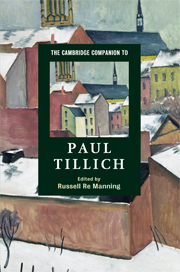Book contents
- Frontmatter
- Part I Standing within the theological circle
- 1 Tillich’s life and works
- 2 Tillich as systematic theologian
- 3 Tillich on God
- 4 Tillich’s Christology
- 5 Tillich’s theology of the concrete spirit
- 6 Faith (and religion)
- 7 ‘First, read my sermons’ Tillich as preacher
- Part II Theology of culture
- Part III Tillich in dialogue
- Bibliography
- Index
2 - Tillich as systematic theologian
from Part I - Standing within the theological circle
Published online by Cambridge University Press: 28 May 2009
- Frontmatter
- Part I Standing within the theological circle
- 1 Tillich’s life and works
- 2 Tillich as systematic theologian
- 3 Tillich on God
- 4 Tillich’s Christology
- 5 Tillich’s theology of the concrete spirit
- 6 Faith (and religion)
- 7 ‘First, read my sermons’ Tillich as preacher
- Part II Theology of culture
- Part III Tillich in dialogue
- Bibliography
- Index
Summary
Characteristically, Paul Tillich begins his Systematic Theology (published in three volumes in 1951, 1957 and 1963) with a section entitled 'Message and Situation' (ST I, 3-6). This section contains the key to his entire project of a theology developed 'in the tension between two poles'; the tension between 'the eternal truth of its foundation and the temporal situation in which the eternal truth must be received' (3). Tillich never departed from this theological vocation; even in his many works on 'social organization' and the 'critiques of the time' (Zeitkritik), notably The Religious Situation (1932) and Theology of Culture (1959), for which he was initially best known. Tillich always wrote from within 'the theological circle' (10). For Tillich, to do theology is to be situated: the truth of theology is based in a particular time. Tillich's insistence on perceiving the relevant 'situation' as 'the totality of man's creative self-interpretation in a special period' and his willingness to undertake the demanding analytical work that this required (an analysis of 'the scientific and artistic, the economic, political, and ethical forms in which they [a people] express their interpretation of existence') sets him apart from the other prominent kinds of twentieth-century theology (4; 3-4). For Tillich, the two poles of message and situation stand in the same relationship to each other as the great kairos to the many lesser kairoi (ST I, 3; ST III, 369-72). Jesus as the Christ is 'the centre of history', the 'transtemporal' central occurrence of the 'great kairos', the only final kairos, the Eschaton (ST III, 364, 366).
- Type
- Chapter
- Information
- The Cambridge Companion to Paul Tillich , pp. 18 - 36Publisher: Cambridge University PressPrint publication year: 2009
- 7
- Cited by



